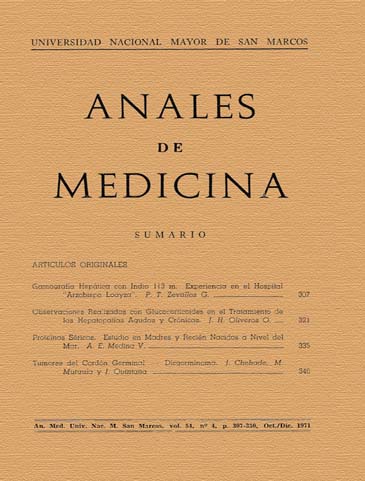Hepatic scintigraphy with Indian 113 m. Experience In The Hospital " Archbishop Loayza"
DOI:
https://doi.org/10.15381/anales.v54i4.5043Abstract
In this study 88 liver scintigraphy were reviewed , showing that the Indian-113-m is a radioisotope of much use and therefore no adverse effects were noted in any of the patients studied. The radiation dose was well below the maximum permissible dose . It can be concluded that liver scintigraphy reaches its highest percentage of positivity in the discarding of liver disease; is very useful for locating tumors in the upper abdomen , as well as to get to the location of pathological processes when the patient has pain in the upper abdomen and hepatomegaly. The main source of confusion in the cases studied was the interpretation of graphic images range corresponding to the liver edges. It was confirmed that liver scintigraphy provides no etiologic diagnoses, so it must be the whole clinical picture to guide the doctor.Downloads
Published
1971-12-31
Issue
Section
Trabajos originales
License
Copyright (c) 1971 Pedro Tomás Zevallos Giampietri

This work is licensed under a Creative Commons Attribution-NonCommercial-ShareAlike 4.0 International License.
Those authors who have publications with this magazine accept the following terms:
- Authors will retain their copyrights and guarantee the journal the right of first publication of their work, which will be simultaneously subject to Creative Commons Attribution License that allows third parties to share the work as long as its author and its first publication this magazine are indicated.
- Authors may adopt other non-exclusive licensing agreements for the distribution of the version of the published work (eg, deposit it in an institutional electronic file or publish it in a monographic volume) provided that the initial publication in this magazine is indicated.
- Authors are allowed and recommended to disseminate their work over the Internet (eg: in institutional telematic archives or on their website) before and during the submission process, which It can produce interesting exchanges and increase quotes from the published work. (See El efecto del acceso abierto ).
How to Cite
1.
Zevallos Giampietri PT. Hepatic scintigraphy with Indian 113 m. Experience In The Hospital " Archbishop Loayza". An Fac med [Internet]. 1971 Dec. 31 [cited 2024 Jul. 2];54(4):307-20. Available from: https://revistasinvestigacion.unmsm.edu.pe/index.php/anales/article/view/5043















